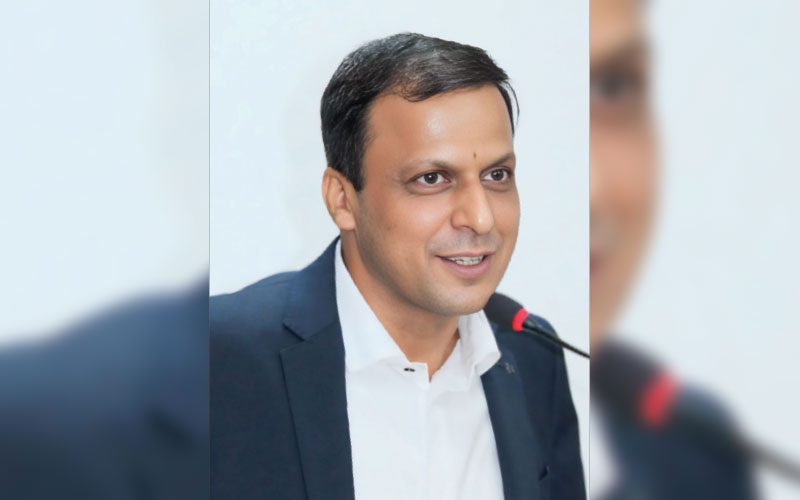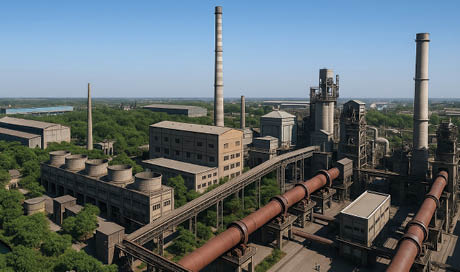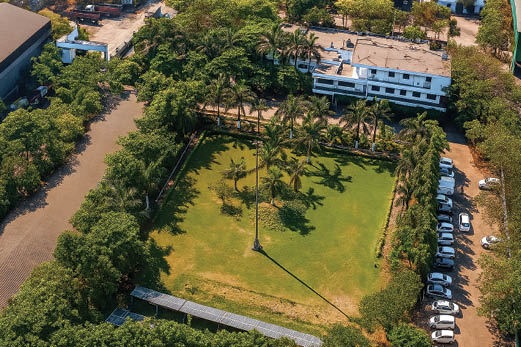REAL Group’s flagship steel wire brand, Real Wire, is gaining strong traction in India’s steel wire industry through strategic investments in green technologies, capacity expansion, and product innovation. In an exclusive interview with Wire & Cable India, Mr. Shiv Agrawal, Director, Real Ispat & Power Limited, said that the adoption of ABB’s energy-efficient motors, VFDs, and hot charging systems has enhanced process control, reduced emissions, and improved wire quality. With a focus on high-tensile, galvanized, and specialty wires, Real Wire is expanding its domestic and global footprint through sustainable, value-driven manufacturing.

Wire & Cable India: Real Ispat & Power (RIPL) has recently acquired advanced green steel technologies from ABB. How do these innovations enhance your overall production of green steel? Will this new technology have an impact on the steel wire segment?
Shiv Agrawal: Real Ispat & Power (RIPL) has integrated cutting-edge green steel technologies from ABB to enhance energy efficiency and environmental performance across its operations. Key installations include high-efficiency IE3 electric motors (ranging from 1.5 kW to 710 kW) and Variable Frequency Drives (VFDs), which are now deployed across core processes such as conveyors, pumps, crushers, and dedusting systems. These systems dynamically adjust motor speed to actual load conditions, significantly optimizing energy consumption. In parallel, the implementation of hot charging of mild steel billets has eliminated the need for re-heating prior to rolling, saving both electricity and fuel while meaningfully reducing CO₂ emissions. Additional improvements, such as coil design modifications in furnaces, have boosted thermal efficiency further.
Beyond these core changes, RIPL has also switched to energy-efficient LED lighting and adopted dolochar—a steelmaking byproduct—as biofuel in boilers. This shift not only enhances energy conservation but also fosters circularity within the production process. These sustained green practices have earned the company accolades, including recognition as a Model Plant by the UNDP, along with multiple regional and national awards.
As for the steel wire segment, the impact of ABB’s technologies is significant, even if indirectly. Products such as wire rods, binding wire, GI wire, HB wire, and barbed wire benefit from upstream improvements. Cleaner and more efficient power delivery to reheating furnaces, rolling mills, and drawing machines leads to improved temperature control and consistent production, which translates into wires with better dimensional accuracy and surface finish. VFDs also contribute by enabling smoother equipment operation, thereby reducing mechanical stress, breakdowns, and downtime in wire-drawing lines. The cumulative cost savings from these energy efficiencies lower the unit cost of production and allow for reinvestment in further wire-processing innovations. Most importantly, these advancements support the creation of low-carbon wire products under RIPL’s brands like Real Wire and GK TMT—an increasingly important differentiator in industrial and infrastructure procurement markets that are becoming more sustainability-driven.
Watch: Top Cable Companies in India
WCI: Can you give us an overview of the company, highlighting its journey and major milestones?
SA: REAL Group, under the visionary leadership of Mr. Rajesh Agrawal (Chairman) and his brothers Mr. Umesh Agrawal and Mr. Ramesh Agrawal, has grown from modest beginnings into one of India’s most respected names in steel manufacturing and infrastructure development. The journey began in 1992 with the trading of cement and steel, and over the past three decades, the group has consistently progressed through strategic investments, backward integration, and a steadfast commitment to quality, innovation, and sustainability.
Some of the major milestones along the way include the acquisition of a traditional rolling mill in 1998, followed by the commissioning of Real Ispat & Power Ltd.—our first greenfield integrated steel plant, in 2004, marking our official foray into manufacturing. In 2011, we acquired Shivalay Ispat & Power Private Limited, a sponge iron unit that further strengthened our backward integration. The momentum continued in 2014 with the acquisition of API Ispat & Powertech Private Limited, another integrated steel plant, effectively doubling our installed capacity. In 2021, we diversified into premium real estate with the launch of Real Spaces, adding a new dimension to our growth strategy. The groundwork for a new ultra-modern steel plant under Real Ispat & Energy Private Limited was completed in 2023, and by 2024, it was successfully commissioned, positioning the group at the forefront of next-generation steel production using advanced green steel technologies.
Today, our product portfolio includes TMT bars under the brand GK TMT, a wide range of steel wire products under the Real Wire brand, sponge iron, and billets. Our installed capacity has more than doubled over the years, and our commitment to advanced technologies reflects our deep focus on sustainability and operational excellence. From a humble trading company to a vertically integrated steel conglomerate, REAL Group has continuously evolved with a vision to build stronger, smarter, and greener infrastructure for India.

This comprehensive approach has allowed us to scale our steel production to a capacity of 0.8 million
metric tons per annum (MMTPA), with capabilities that align with modern demands for sustainability, precision, and scalability.
WCI: Kindly describe your manufacturing setup and production capacities.
SA: REAL Group, under its flagship brand, operates a robust and integrated manufacturing ecosystem that spans multiple group companies, ensuring synergy, efficiency, and consistently high-quality output across the entire steel value chain. Our manufacturing infrastructure is spread across four core units: Real Ispat & Power Limited (RIPL), API Ispat & Powertech Private Limited (API), Shivalaya Ispat Power Private Limited (SIPPL), and Real Ispat & Energy Private Limited (RIEL). These group companies collectively enable us to operate seamlessly across all major steel processing stages—from sponge iron and billet production to rolling and finishing operations.
In addition to our vertically integrated setup, we are also backed by in-house power generation and advanced automation technologies that optimize energy efficiency and operational performance. This comprehensive approach has allowed us to scale our steel production to a capacity of 0.8 million metric tons per annum (MMTPA), with capabilities that align with modern demands for sustainability, precision, and scalability.
WCI: Please tell us about your product portfolio, especially in the steel wire segment, and its application areas.
SA: At REAL Group, we offer a diverse and high-quality portfolio of both finished and intermediate steel products that cater to a wide range of sectors including construction, infrastructure, industry, and agriculture. Among these, the steel wire segment, marketed under our “Real Wire” brand—has emerged as a fast-growing vertical and a strategic focus area for the company.
Our manufactured finished products include GK TMT Re-bars, known for their high strength and superior ductility, produced using Thermax QST technology—ideal for critical infrastructure and seismic-prone zones. We also manufacture hot-rolled wire rods under the Real Wire brand, which serve as base material for various wire products.
In the steel wire segment, we produce a comprehensive range of value-added wire products using advanced wire drawing and galvanizing lines. These facilities ensure superior tensile strength, ductility, and corrosion resistance. Our wire rods are produced using automatic rolling mills with horizontal-vertical rolling technology, Siemens automation, and PLC & SCADA-controlled operations. Our dedicated in-house R&D team collaborates with IITians and researchers to consistently refine product quality. These wire rods are used as feedstock for cold drawing into wires, and find application in fasteners, welding electrodes, automobile springs, screws, rivets, and industrial tools.
We also produce HB wire (Hard Bright wire) used in fasteners, nails, wire meshes, and automotive parts; binding wire for tying reinforcement in RCC work, packaging, cable industries, and fabrication shops; Galvanized Iron (GI) wire used for fencing, cable armoring, electrical grounding, and agricultural trellising; and barbed wire, commonly used for security fencing across farms and industrial perimeters.
On the intermediate side, we produce sponge iron and billets in-house, which serve as a clean and consistent steel base. We also operate 94 MW of captive power, ensuring reliability and cost-efficiency, and manufacture eco-bricks from steel plant by-products to promote sustainable construction.
The Real Wire product range benefits from complete backward integration, enabling us to maintain consistent quality, achieve cost efficiency, and ensure faster delivery to the market. Our wire products are increasingly gaining preference in key sectors such as construction, agriculture, telecom, and security due to their strength, durability, and corrosion resistance.

The Real Wire product range benefits from complete backward integration, enabling us to maintain consistent quality, achieve cost efficiency, and ensure faster delivery to the market.
WCI: Can you tell us about your recent developments and major projects undertaken by the company?
SA: REAL Group has been actively undertaking major developments across its facilities to enhance operational efficiency, expand capacity, and lead the transition toward greener, technology-driven steel production. One of the most significant milestones was the successful commissioning of Real Ispat & Energy Private Limited (RIEL) in 2024. Located in Bhatapara, Chhattisgarh, this new integrated steel facility is our most advanced unit to date. It features state-of-the-art automation and energy-efficient systems powered by ABB’s green steel technologies. Designed for future readiness, RIEL is built to accommodate low-carbon steel production, positioning us at the forefront of environmentally conscious steelmaking in central India.
Another major development is the adoption of ABB’s advanced green steel technologies across all our plants. We have deployed IE3 energy-efficient motors and Variable Frequency Drives (VFDs) to optimize power usage across key equipment. Additionally, the implementation of hot charging technology in rolling mills has eliminated the need for billet reheating, significantly reducing both energy consumption and carbon emissions. These measures are central to our broader strategy of moving toward low-emission, high-efficiency steelmaking.
In our Real Wire division, we have scaled up both production capacity and market reach. This includes the development of thicker wire rod sections (14mm and 16mm), as well as the expansion of automation in wire drawing and galvanizing lines. These upgrades allow us to serve a growing range of sectors, including infrastructure, agriculture, and rural fencing. Real Wire is now a key contributor to our group revenue and is strengthening brand visibility, particularly in semi-urban and rural markets.
We are also advancing our digital transformation through the implementation of ERP-integrated systems for production, sales, and procurement—namely, the REAL DEALS platform. Additionally, we are developing a centralized Quality Management System (QMS) to ensure uniform process control and full traceability across our operations. This system is especially valuable for meeting the compliance and assurance needs of government and institutional buyers, reinforcing our commitment to quality and customer confidence.
WCI: Can you tell us about your market footprint and key clientele for steel wire products? Do you cater to international markets?
SA: REAL Group, under the brand “Real Wire,” has developed a robust and expanding footprint in the Indian steel wire industry. Our product line, which includes HB wire, binding wire, GI wire, and barbed wire, caters to a wide range of applications spanning construction, infrastructure, agriculture, power transmission, and public development projects. These wire products have become integral to rural fencing, structural reinforcement, and electrification efforts, contributing significantly to various government and private initiatives.
Geographically, we hold a strong presence in states such as Chhattisgarh, Odisha, Maharashtra, West Bengal, Madhya Pradesh, Jharkhand, and Uttar Pradesh. Our extensive and growing dealer network continues to expand into Tier-2 and Tier-3 cities, further strengthening our domestic market outreach. This network is supported by more than 300 active dealers and distributors who serve regional hardware markets and local building material hubs.
Our key clientele includes institutional buyers such as EPC contractors involved in infrastructure and rural electrification, as well as various state departments participating in public procurement schemes. We regularly participate in government tenders, especially for barbed and GI wires. In addition to institutional and retail clients, we also serve OEMs and industrial users, including structural fabricators and local manufacturing units that rely on high-quality mild steel wires for their operations.
While our primary focus remains on the Indian market, we have also taken strategic steps toward international expansion. We have initiated trial exports of wire rods, HB wires, GI wires, and binding wires to countries such as Nepal, the UAE, and Bangladesh. Encouraged by growing interest, we are in the process of establishing a dedicated export vertical that will focus on high-potential regions including South Asia, East Africa, and the Middle East. We maintain strict adherence to BIS and ISO standards, and our infrastructure is well-equipped to support international clientele with consistent product quality and on-time delivery.
WCI: How do you see Indian steel wire manufacturers competing with global players in terms of quality, pricing, and technological advancements?
SA: Indian steel wire manufacturers have made significant strides over the past decade and are now increasingly competitive with global players in terms of quality, pricing, and technological sophistication. On the quality front, manufacturers like REAL Group have adopted rigorous quality control frameworks, including BIS and ISO certifications, as well as internal QA protocols, to consistently meet international standards. Our wire drawing facilities incorporate advanced technologies such as inline zinc coating and precision lab testing, ensuring performance consistency across varied applications—from large-scale infrastructure to agriculture. Products like HB wire, GI wire, and binding wire are subjected to thorough testing for tensile strength, elongation, and corrosion resistance, placing them on par with offerings from European and Southeast Asian producers.
When it comes to pricing, India enjoys a natural edge due to its access to abundant raw materials such as iron ore and billets, availability of low-cost skilled labor, and the presence of integrated steel plants equipped with captive power generation. Real Group’s own backward integration—from power to steel—and our operational scale allow us to deliver high-quality wire products at globally competitive prices. This cost efficiency translates into enhanced value for both domestic and international clients.
Technologically, Indian manufacturers are increasingly adopting automation and process optimization. PLC-based automation systems, energy-efficient furnaces, and advanced galvanizing techniques are now common. At REAL Group, the adoption of ABB’s green steel technologies has enabled us to minimize emissions while enhancing energy efficiency and production output. Furthermore, many manufacturers are integrating Industry 4.0 solutions like ERP systems, IoT sensors, and digital quality monitoring to optimize supply chains and product traceability.
Looking ahead, with sustained investments in R&D, infrastructure, and sustainability, Indian wire manufacturers are well-positioned not just to meet but to exceed global benchmarks. Increasing collaborations with international buyers, EPC contractors, and OEMs reflect growing global confidence in Indian wire producers’ reliability, consistency, and ability to scale.

One of the most significant milestones was the successful commissioning of Real Ispat & Energy Private Limited (RIEL) in 2024. Located in Bhatapara, Chhattisgarh, this new integrated steel facility is our most advanced unit to date.
WCI: Sustainability is the nucleus of the manufacturing sector. Have you incorporated sustainability initiatives in your manufacturing operations?
SA: Yes, sustainability lies at the core of our operational philosophy at REAL Group. We have embedded a comprehensive and forward-looking approach to sustainable manufacturing through our Green Steel Journey. Our initiatives span across energy management, emissions reduction, waste reuse, and digital transformation. We conduct real-time energy and emissions monitoring, with data directly transferred to environmental bodies like the CECB and CPCB. Emission levels across critical operations—such as the power plant, rolling mill, steel melting shop (SMS), DRI, and boiler stacks—are stringently monitored to stay within permissible limits (e.g., PM10: 100 µg/m³, SO₂: 80 µg/m³).
On the waste management front, we actively reuse dolochar, fly ash, and fugitive dust, supported by automated dust extraction systems and zero-discharge wastewater systems that facilitate resource conservation. Energy efficiency is driven by process optimization measures such as hot charging of billets to eliminate reheating, direct sponge iron transfer to induction furnaces using closed circuit systems, and the replacement of dampers with drives in DRI kilns—all of which significantly cut energy consumption and emissions. Air quality within the plant is also prioritized using vehicle misting, wheel pressure washing systems, and dust suppression techniques.
Beyond process-level changes, we are committed to environmental stewardship through continuous green belt development and plantation drives within our campuses. These efforts are complemented by strategic certifications like ISO 50001 for Energy Management and a fully digitized, paperless office ecosystem—further reducing our environmental footprint. Together, these integrated efforts reaffirm our commitment to building a cleaner, greener future for Indian steel manufacturing.

In our Real Wire division, we have scaled up both production capacity and market reach. This includes the development of thicker wire rod sections (14mm and 16mm), as well as the expansion of automation in wire drawing and galvanizing lines.
WCI: What are the current trends shaping the wire and cable industry in India, especially the steel wire sector?
SA: The Indian wire and cable industry is witnessing a major transformation, driven by rapid infrastructure development, technological advancement, and a strong shift toward sustainability. At REAL Group, we closely monitor these trends and strategically align ourselves with them. A key driver is the surge in infrastructure-led demand, fueled by government initiatives like the National Infrastructure Pipeline, PM Gati Shakti, and Saubhagya. These programs are pushing the need for high-performance wire and cable products—including steel wires—for structural reinforcement and power distribution, especially across growing urban and rural networks.
Sustainable manufacturing is becoming central to this evolution. REAL Group is deeply invested in the green steel movement, incorporating emission-controlled production lines, real-time pollution monitoring (integrated with CECB and CPCB), reuse of industrial by-products like dolochar and fly ash, and zero-liquid discharge systems. Our MIRROR philosophy—Monitoring, Innovation, Reduction, Reuse, Optimization, and Replenishment—underpins our commitment to India’s Net Zero 2070 vision.
We’re also seeing a clear shift in customer preference toward eco-friendly, high-performance products such as low-smoke, halogen-free, and fire-retardant cables, alongside anti-corrosive and alloy-coated steel wires. REAL Group is exploring value-added steel wire applications in critical sectors like tunneling, power grids, and telecom tower reinforcement. Digitalization is another game changer, with Industry 4.0 tools—AI-based quality control, IoT monitoring, and predictive maintenance—being adopted widely. REAL Group is advancing with 100% paperless customer operations, as well as automation across its SMS, DRI, and rolling units for better consistency.
Export momentum is also rising, as global players diversify away from China. REAL Group is leveraging this opportunity by expanding into international markets with premium-grade steel wire offerings. Another emerging trend is the entry of large conglomerates into the wires and cables sector, triggering consolidation, brand-driven competition, and increased R&D and compliance investments. We see this as a positive shift that raises industry standards and fosters innovation.
In conclusion, the wire and cable sector—particularly steel wires—will play a vital role in shaping India’s infrastructure and sustainability landscape. At REAL Group, we are fully committed to being a key enabler of this transformation, blending capacity growth with conscientious manufacturing.

To begin with, we are significantly investing in capacity expansion and product diversification, especially in high-tensile steel wires, galvanized and coated wires, and specialty products tailored for the construction, automotive, telecom, and utility sectors.
WCI: What are the challenges faced by the Indian steel wire industry? How do you see the industry overcoming these challenges?
SA: The Indian steel wire sector, despite its steady growth, faces several structural, environmental, and operational challenges. At REAL Group, we recognize these complexities and are aligned with a proactive roadmap to address them. One of the foremost issues is the volatility in raw material prices—with frequent fluctuations in iron ore, sponge iron, coal, and ferroalloys affecting production costs and profit margins, especially for long products and specialty wires. We believe the industry will increasingly adopt strategic sourcing, inventory hedging, and a shift toward green inputs to stabilize costs and ensure resilience.
Another pressing challenge is environmental compliance and emission control, as CPCB, NGT, and MoEF regulations become more stringent. Meeting production targets while staying within permissible emission norms is no small feat. At REAL Group, we’ve responded by implementing real-time emission monitoring systems, zero-liquid discharge processes, and comprehensive dust suppression measures. We expect wider adoption of such sustainability-focused practices—along with certifications like ISO 50001—to become industry norms.
The fragmented nature of the steel wire industry and the dominance of unorganized players also create challenges. Quality inconsistencies, tax evasions, and pricing disparities often affect the competitiveness of organized, compliant manufacturers. However, with growing consumer awareness, tighter regulatory oversight, and GST-led transparency, we anticipate a shift toward the formal sector. Branding, certification, and customer trust will increasingly serve as critical differentiators.
Technological gaps and process inefficiencies further hinder industry productivity. Many smaller units continue operating with outdated setups, leading to low energy efficiency and higher rejection rates. Future growth, in our view, lies in embracing automation, digital twins, and AI-based quality control systems. At REAL Group, we’ve already deployed drive-based systems, closed-loop automation, and hot charging mechanisms to boost energy efficiency and output quality.
Another challenge is the shortage of skilled manpower and inadequate adherence to safety standards across many facilities. This impacts both productivity and operational integrity. We advocate for investments in workforce upskilling, digital training tools, and structured safety certification programs. REAL Group conducts regular in-house training and third-party safety audits to maintain a culture of safety and excellence.
Lastly, international trade competition and import threats—particularly from countries with surplus steel capacity—pose risks to domestic manufacturers. Strategic measures such as anti-dumping duties, Quality Control Orders (QCO), and the reinforcement of the ‘Make in India’ initiative are essential for safeguarding local producers. REAL Group is also diversifying through export initiatives to mitigate these risks and tap into global demand.
In summary, while the Indian steel wire industry faces a range of challenges, a combination of technology adoption, policy support, quality focus, and sustainability will help it evolve into a globally competitive sector. At REAL Group, we remain committed to being at the forefront of this transformation.
Also Read: Asahi Ropes Targets High-Potential Export Markets, Plans Capacity Expansion Up to 12,000 MT
WCI: What are your future growth plans aimed at strengthening your market position in the steel wire segment?
SA: At REAL Group, we are deeply committed to achieving long-term leadership in the steel wire segment by aligning our growth strategy with evolving market demands, sustainability imperatives, and value-driven innovation. Our roadmap is built around scaling our capacity, enhancing product quality, and expanding our presence in both domestic and international markets.
To begin with, we are significantly investing in capacity expansion and product diversification, especially in high-tensile steel wires, galvanized and coated wires, and specialty products tailored for the construction, automotive, telecom, and utility sectors. Our goal is to strengthen our portfolio in value-added and performance-critical wire solutions, meeting the needs of modern infrastructure and industrial projects.
We are also advancing our Green Steel initiatives, integrating electric arc furnaces to lower carbon emissions and expanding our zero-discharge systems, energy optimization technologies, and green belt developments. This is part of our larger mission to lead in eco-friendly, low-emission steel manufacturing, aligned with India’s Net Zero 2070 vision.
On the technology front, we are upgrading our operations with hot charging processes, closed-loop sponge iron transfers, and drive-based automation. Innovations such as real-time emission monitoring, automated dust suppression systems, and digital twin modeling are being explored to ensure higher precision, energy efficiency, and consistent product quality in wire manufacturing.
In terms of market expansion, we are actively targeting new demand hubs in Eastern and Southern India, while deepening ties with EPC contractors, OEMs, and infrastructure clients. Internationally, we are expanding our export outreach to regions like South Asia, Africa, and the Middle East—strategically growing our footprint in emerging global markets.
Digital transformation is another key pillar of our strategy. We have transitioned to 100% digital customer operations, integrating ERP and CRM systems to streamline business transactions, enhance transparency, and improve turnaround times. A smart supply chain framework is being built to support agile, customer-centric delivery models.
Finally, to ensure sustainable growth, we are investing in workforce development through structured skilling programs, partnerships with training institutes, and regular training in safety, ethics, and environmental compliance. This is aimed at nurturing a future-ready talent pool that aligns with both global quality standards and our own operational excellence.
In essence, our future growth plans for the steel wire segment are comprehensive, focusing on innovation, sustainability, technology, and human capital to strengthen our market position and deliver long-term value to all stakeholders.






